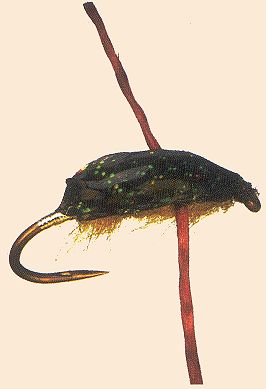Waterboatmen
By Carl Bruhn
From Fly Fishing British Columbia, Published
by Interactive Broadcasting Corporations, distributed by
Frank Amato Publications.
We appreciate use permission.
Publisher's Note: Here's one to start tying for spring and
ice-out on Canadian lakes! Fly photo and recipe below.
Although available year-round, waterboatmen only slip onto the menu
of stillwater trout immeidately after ice-off and again in the late
fall. These stillwater beetles are common inhabitants of the shallows
in productive lakes throughout British Columbia. Breathing through
a process known as plastron respiration, waterboatmen are air-breathing
insects, making them prisoners of the shallows. Trapping a bubble of
air against their bodies, boatmen have a distinct silvery shine which
often masks their true body color. Radiant patterns featuring mylar,
Flashabou or Krystal Flash are required to mimic this sheen and are
essential when trout feed selectively.
Boatmen are often mistaken for their larger cousins, the backswimmers.
Characterized by dark backs and light bellies the color of masking
tape, waterboatmen seldom exceed half an inch in length. Backswimmers
have light backs and dark bellies and grow as long as three quarters
of an inch. The prominent oar-like legs common to both insects should
be a primary feature on any pattern.
Prime time to fish boatmen imitations is in the late fall after the
first frosts of the season. Capable of flight, mature boatmen mate
and disperse, crashing headlong into lakes all over the south-central
interior of the province. These cascading boatmen give the illusion
of rainfall. Slamming onto the surface of the water, boatmen spin
wildly, as though knocked senseless by the impact. After breaking
through the surface film, boatmen scoot down to the bottom, depositing
their eggs on weeds and other subsurface debris. Trout sometimes
become fixated on the surface-spinning boatmen. Traditional patterns
will not tempt these selective fish, but anglers lucky enough to have
buoyant boatmen patterns in their fly boxes can reap huge rewards
at this time.
The key to successful presentation is duplicating the U-shaped path
boatmen follow as they travel to and from the bottom to replenish
their oxygen supply. In shallow water, weighted patterns fished on
floating lines are effective, provided the front portion of the hook
is weighted, achieving the nose-down attituge of diving boatmen. In
water deeper than 10 feet, a high-density, full-sinking line works
well. The heavy belly section of traditional full-sinking lines
pulls the fly down to the bottom as it sinks. A brisk, choppy strip
retrieve back to the surface completes the U-shaped travel path.
No matter what presentation technique is used, strikes are invariably
savage. The rapid sculling swim of the waterboatmen causes trout
to strike quickly and agressively.

Krystal Boatman
Tied by Phil Rowley
Hook: TMC 3769, #10 - 14.
Thread: Black. 6/0 or 8/0.
Tag: Silver Flashabou.
Shell Back: Black Krystal Flash.
Body: Yellow to tan dubbing spun in a loop of pearl,
and silver Krystal Flash.
Legs: Brown or olive Super Floss.
Our Man In Canada Archives
|



